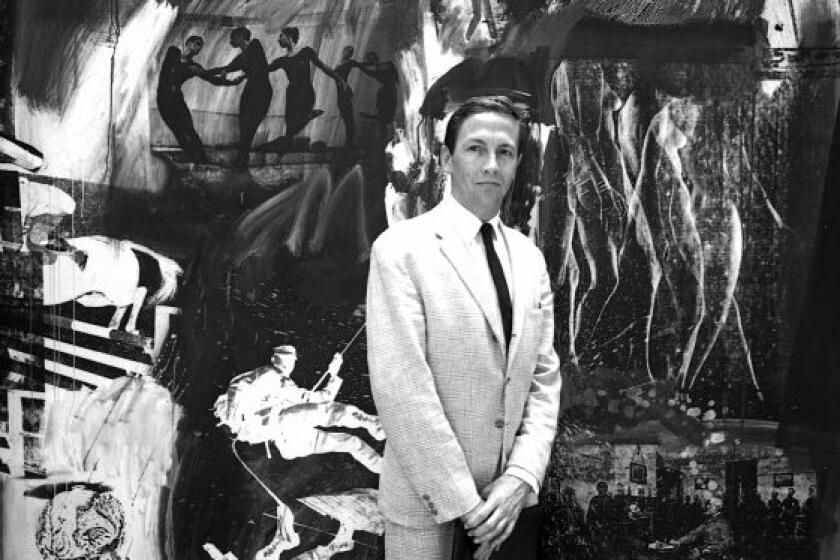Rattle Renews His L.A. Connection
Simon Rattle may be a world-class conductor of world-class orchestras, but he is also unpretentious enough to preface an at-home morning interview by making his own pot of coffee. “I’m no good till I’ve had my second cup,” he said with a smile. Then sitting at the cozy but cramped kitchen table, he asks, “Would you mind if we stayed here to talk?”
Home in this case is the San Marino residence of friends, with whom the British-born Rattle, his wife, American soprano Elise Ross, and their 4-year-old son, Sasha, stay when Rattle fulfills his duties as principal guest conductor of the Los Angeles Philharmonic.
This morning’s topic of conversation is not the Philharmonic, however, but the first U.S. tour of the City of Birmingham Symphony, of which Rattle, 33, has been principal conductor and artistic adviser since 1980. Since Rattle has taken over the Birmingham ensemble, it has grown in stature to the point that it is now attracting more media attention and a more loyal audience in England than London’s high-powered symphonies.
The three-week tour begins tonight at the Orange County Performing Arts Center in Costa Mesa and continues with four performances at the Dorothy Chandler Pavilion, Thursday through Sunday, as part of the UK/LA Festival.
“It’s the most sensationally civilized American tour I’ve ever seen,” Rattle said, “because we spend eight or nine days on the West Coast and eight or nine days in New York, Boston and Washington. We don’t have to do a lot of charging about the country on one-night stands.”
Tonight, the Segerstrom Hall program lists Haydn’s Symphony No. 70, the Seventh Symphony by Sibelius, Stravinsky’s “Petrushka” and “La Valse” by Ravel. For the Thursday, Friday and Sunday performances the orchestra will play the U.S. premiere of British composer Robin Holloway’s “Seascape and Harvest,” Sibelius’ Seventh and “Petrushka.” The concert on Saturday offers Sibelius’ last three symphonies--Nos. 5, 6 and 7.
About the Holloway work, Rattle said, “I told Robin to write a great big sexy Mahler symphony for us, and he did.
“It’s very accessible, very gorgeous. The piece is almost a gesture of friendship to myself and the orchestra--a lot of our favorite pieces are somehow echoed in it. One hears little bits of ‘La Mer,’ Mahler’s Ninth, Bruckner’s Ninth, Elgar, Gershwin, all woven in a half-hour tapestry.”
Sibelius has become an orchestra specialty, Rattle feels, in part because the English musicians know firsthand the kind of cold, inhospitable climate depicted in the Finnish composer’s works.
“These pieces seem to me to have little to do with human beings at all, but with absolutely gigantic forces of nature that humans can’t control. That’s the type of intensity they have--the power of nature is very evident and inescapable.”
As for his own affinity for the composer, Rattle noted, “There’s a lot of Scandinavian music I love. Nielsen is also very close to me.
“Often we try not to do music that’s been played an enormous amount--particularly when we’re touring and recording. Why do it? Relying on the staples of the symphonic diet is not good for audiences, the musicians and, more than anything, it’s not good for the music itself. When an audience comes to a great work and says, ‘My God, not again,’ that work becomes unvalued.”
In championing Sibelius, the orchestra is maintaining a tradition begun even before its formal organization in 1920, under the baton of Sir Edward Elgar.
Birmingham had long been a center for the performance of orchestral music, its triennial festival in the 1800s and early 1900s offering first performances of works by Sibelius, Dvorak, Gounod and other noted composers of the time. Mendelssohn wrote a number of pieces, including “Elijah,” for the orchestra.
When Rattle took over the 100-member group he found “a very refined sound, with a marvelous instinct for textures. That was a marvelous thing to come to, because it’s harder to instill. We’ve since set up that the orchestra work in great detail.”
The Birmingham players, most of whom are in their 20s, have become particularly adept at performing contemporary works, reflecting their home audience’s and Rattle’s passion for such music.
“It’s a matter of attitude,” according to their conductor. “When these players see a new piece they don’t think it’s unpleasant music, as very often happens. And working with living composers, you’re a lot closer to the creative process, which the orchestra appreciates.”
There are some notable stylistic differences between the English orchestra and their Los Angeles cousins, Rattle said.
“L.A. has always been an orchestra of big-boned, generous, gutsy playing, much more brilliantly colored and rich. Birmingham tends to be more chamber-music-oriented, with detail and finesse. They have a most extraordinary control of quiet dynamics, which gives you an enormous range. It’s always been fascinating to me how different a program will sound depending on the group playing it. You conduct to each orchestra’s strengths, almost without realizing it.”
The Philharmonic is also richer monetarily; the Birmingham players earn only about one-quarter the minimum Los Angeles salary, a situation Rattle has fought to improve throughout his tenure.
“It’s a vocation, like nursing, to be a musician in England. It’s something you do for love--you cannot consider it a serious profession in terms of financial rewards or comforts.”
There are also enormous differences between Birmingham and American audiences, Rattle says. “In the best English audiences, there is a kind of communion with the music and intent, active listening one very rarely finds in America. Here (the U.S.) it’s much more passive.”
Rattle says he does not feel undue pressure in presenting his orchestra to the city he calls his second home.
“We’re all very excited about it. I’m very much looking forward to the two orchestras getting together.”
After the tour Rattle will take a six-month sabbatical, much of which he and his family will spend exploring Indonesia. He has no intention of relinquishing his Birmingham post in the near future, he says: Together with conductor Esa-Pekka Salonen and the London Sinfonietta, he is planning an annual, monthlong festival which each year will cover one decade of 20th-Century music.
“In 1991 we’ll do a historical cross section of the years 1900-1910, and by the year 2000 we’ll have caught up with ourselves, playing 1990’s pieces by composers who are now schoolchildren.
“They’re not going to get rid of me that easily,” he added. “It’s too important to me, there’s too close a connection.
“When you have a group with whom you can conduct what you want, who’s open to everything, you don’t throw that away. I’m one of the luckiest musicians alive.”
More to Read
The biggest entertainment stories
Get our big stories about Hollywood, film, television, music, arts, culture and more right in your inbox as soon as they publish.
You may occasionally receive promotional content from the Los Angeles Times.






